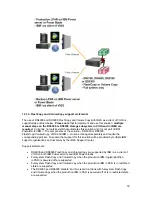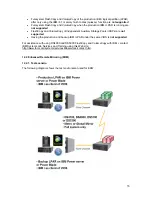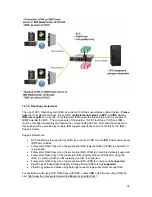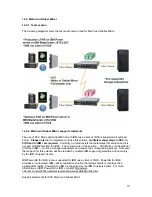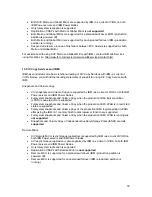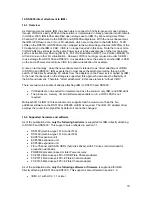
24
version of Disk Magic includes support for multiple open storage subsystems and IBM i as a
virtual client of VIOS.
9.3. Dual hosting and multi-path I/O (MPIO)
An IBM i client partition in this environment has a dependency on VIOS: if the VIOS partition fails,
IBM i on the client will lose contact with the virtualized open storage LUNs. The LUNs would also
become unavailable if VIOS is brought down for scheduled maintenance or a release upgrade. To
remove this dependency, two or more VIOS partitions can be used to simultaneously provide
virtual storage to one or more IBM i client partitions.
9.3.1. Dual VIOS LPARs with IBM i mirroring
Prior to the availability of redundant VIOS LPARs with clients-side MPIO for IBM i, the only
method to achieve VIOS redundancy was to use mirroring within IBM i. This configuration uses
the same concepts as that for a single VIOS described in section 8.2. In addition, at least one
additional virtual SCSI client adapter exists in the client LPAR, connected to a virtual SCSI server
adapter in the second VIOS on the same Power server. A second set of LUNs of the same
number and size is created on the same or a different open storage subsystem, and connected to
the second VIOS. The host-side configuration of the second VIOS mimics that of the first host,
with the same number of LUNs (hdisks), vtscsiX and vhostX devices. As a result, the client
partition recognizes a second set of virtual disks of the same number and size. To achieve
redundancy, adapter-level mirroring in IBM i is used between the two sets of virtualized LUNs
from the two hosts. Thus, if a VIOS partition fails or is taken down for maintenance, mirroring will
be suspended, but the IBM i client will continue to operate. When the inactive VIOS is either
recovered or restarted, mirroring can be resumed in IBM i.
9.3.2. Path redundancy to a single set of LUNs
Note that the dual-VIOS solution above provides a level of redundancy by attaching
two separate
sets
of open storage LUNs
to the same IBM i client through separate VIOS partitions.
It is not an
MPIO solution that provides redundant paths to a
single set
of LUNs. There are two
MPIO
scenarios possible with VIOS that remove the requirement for two sets of LUNs:
•
A single VIOS partition using two Fibre Channel adapters to connect to the same set of
LUNs
•
Two VIOS partitions providing redundant paths to the same set of LUNs on a single open
storage subsystem
9.3.2.1. Path redundancy with a single VIOS
If a VIOS LPAR has two or more Fibre Channel adapters assigned and the correct host
configuration is created in the open storage subsystem, VIOS will have redundant paths to the
LUNs connected to the Fibre Channel adapters. VIOS includes a basic MPIO driver, which has
been the default instead of the RDAC (Redundant Disk Array Controller) driver since November
2008. The MPIO driver can be used with any storage subsystem which VIOS supports and is
included in a default install. In this case, configuration is required only on the storage subsystem
in order to connect a single set of LUNs to both ports on a Fibre Channel adapter owned by VIOS.
This multi-path method can be configured in two ways: round-robin, or failover. For storage
systems like XIV and DS8000 that support active-active multi-path connections, either method is
allowed. Path failover will use one path and leave the other idle until the first path fails, while
round-robin will always attempt to use both paths if available to maximize throughput. For
Summary of Contents for I VIRTUALIZATION - READ ME FIRST 7-9-2010
Page 13: ...13...























